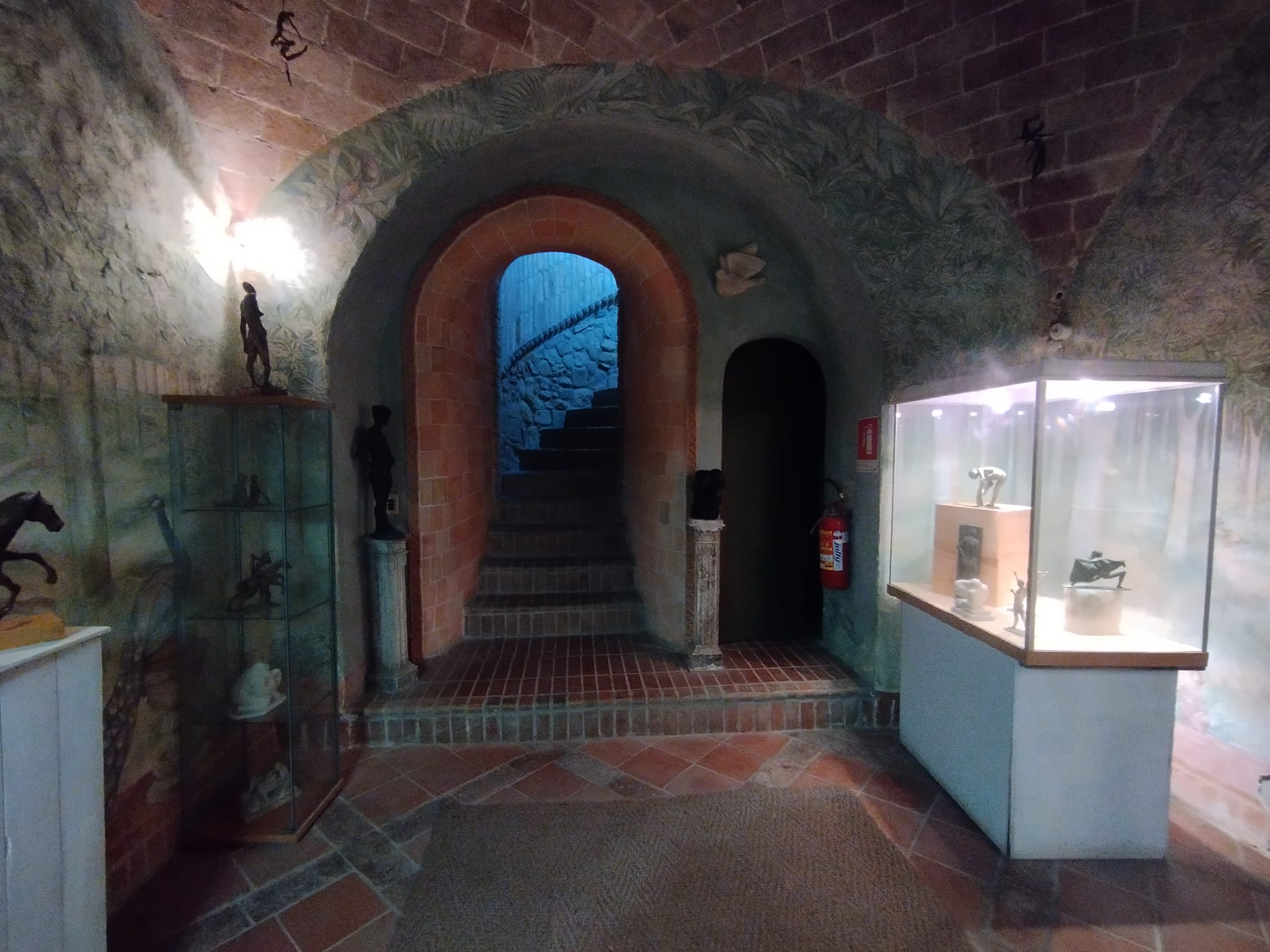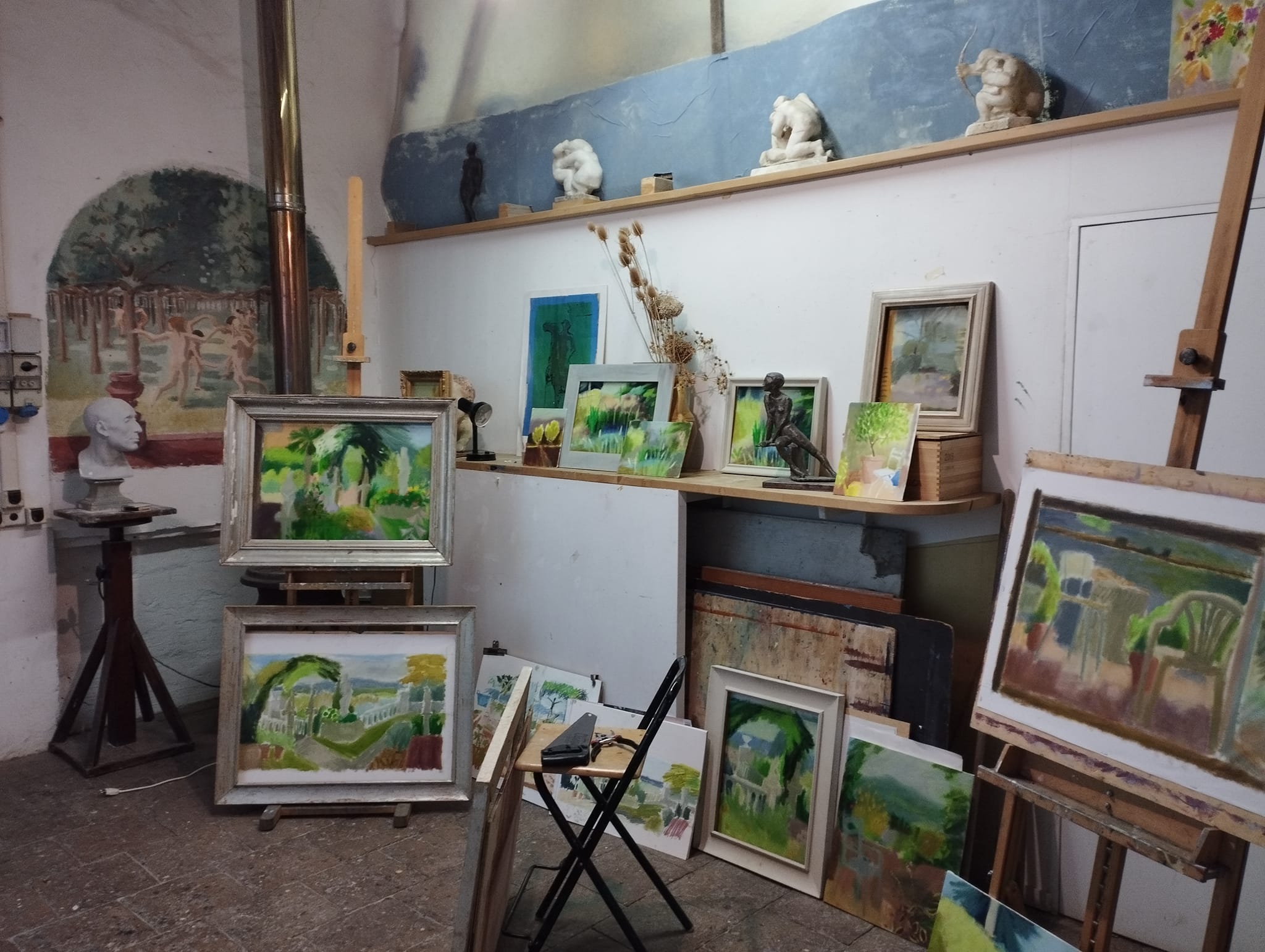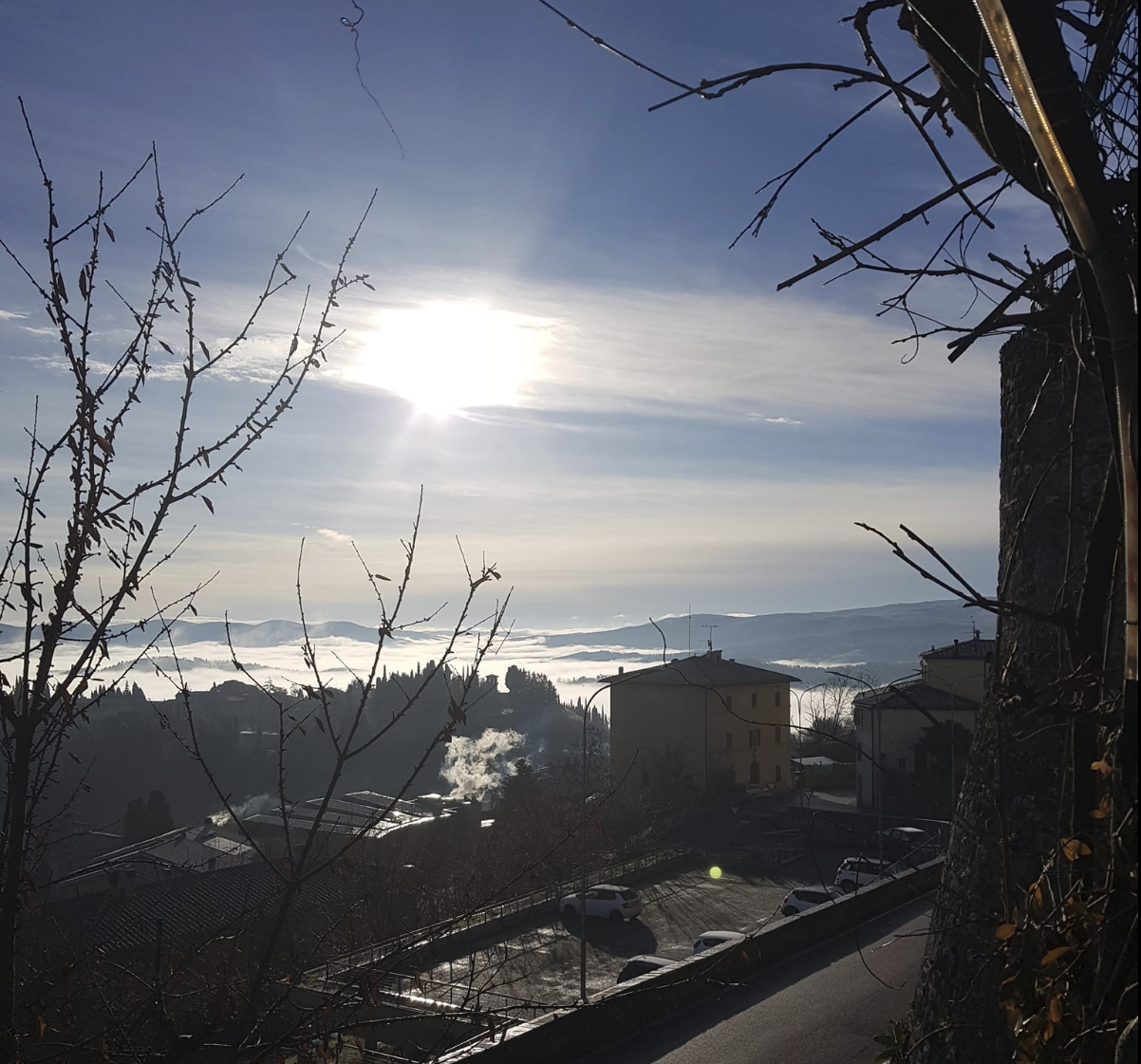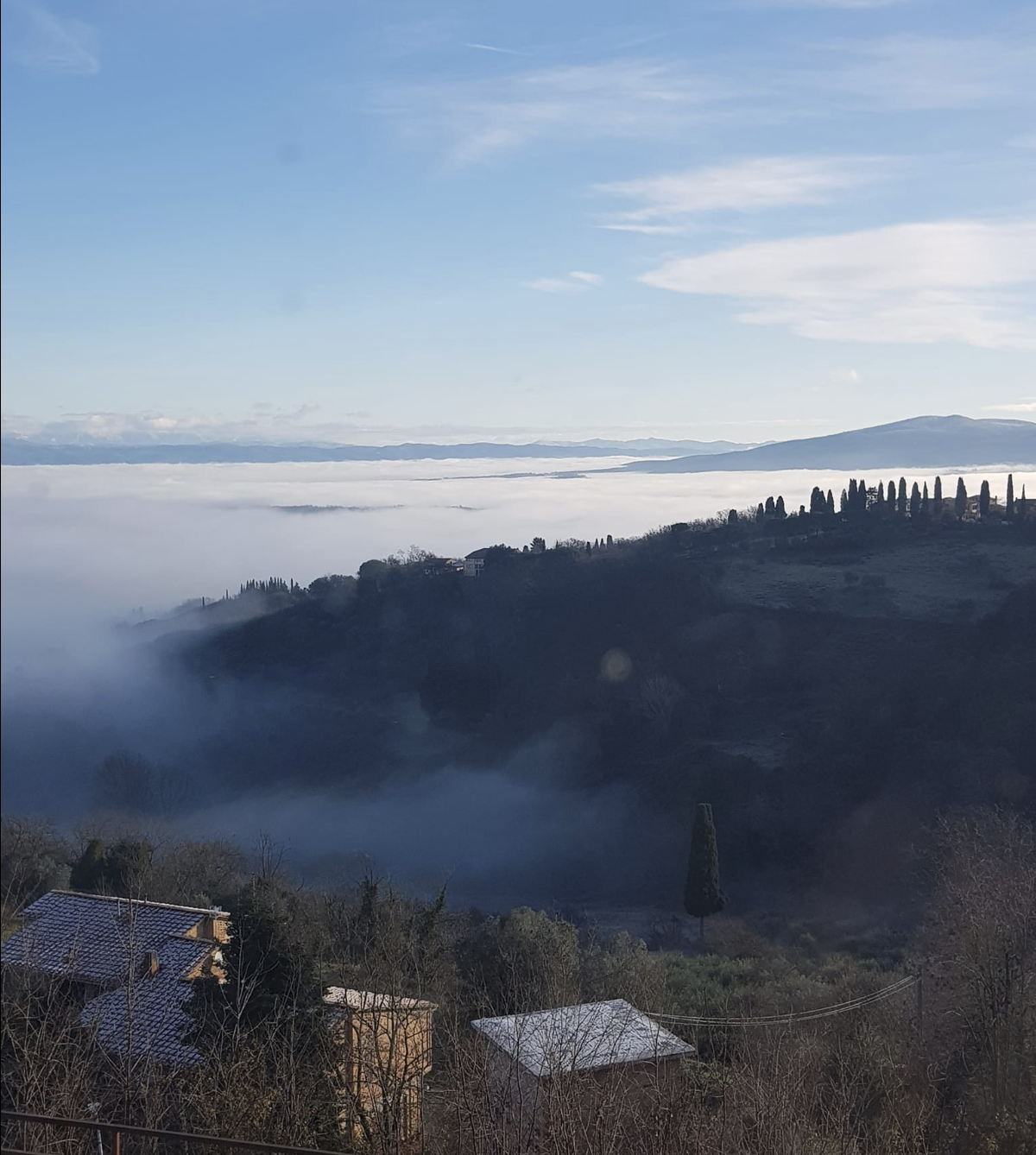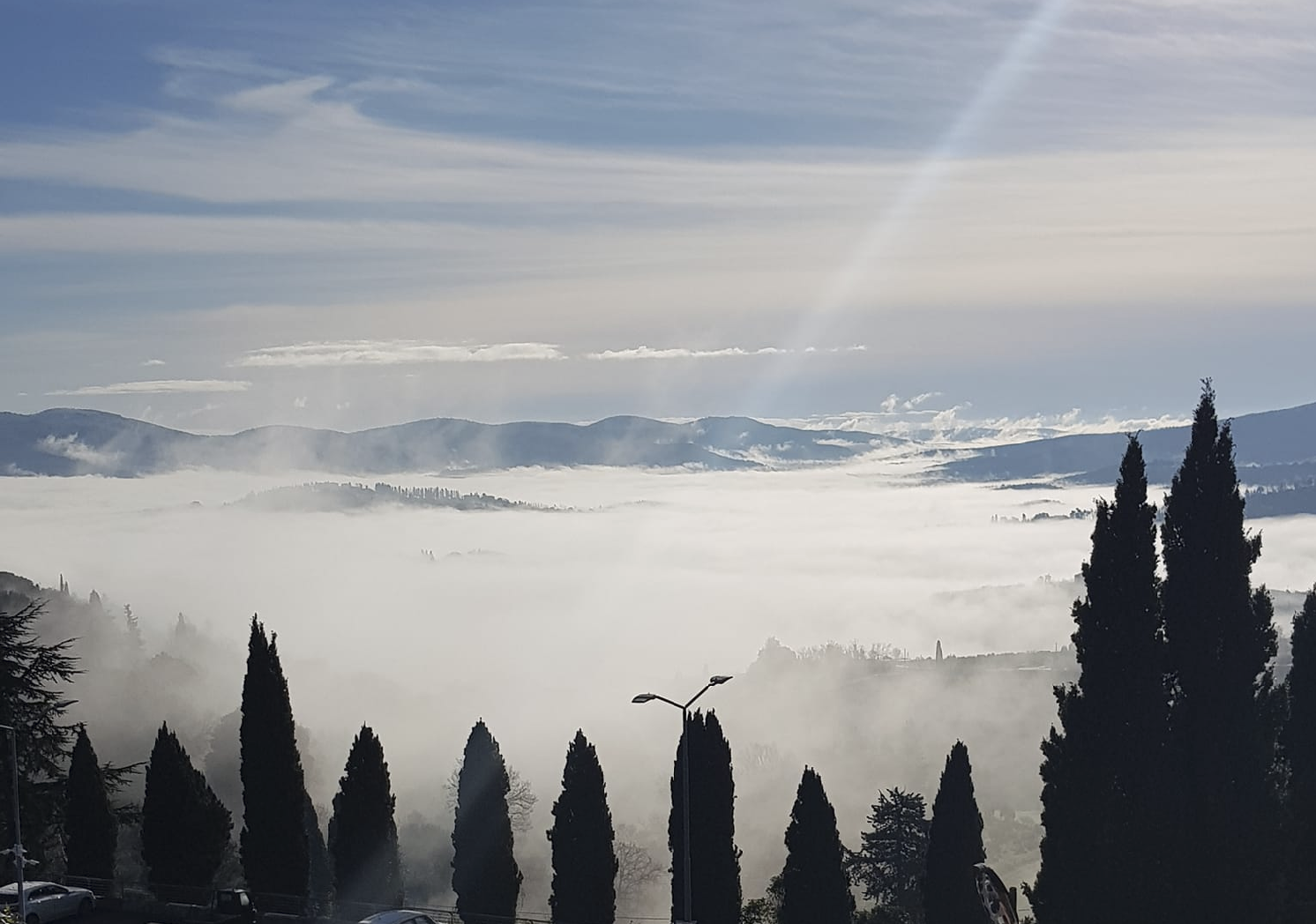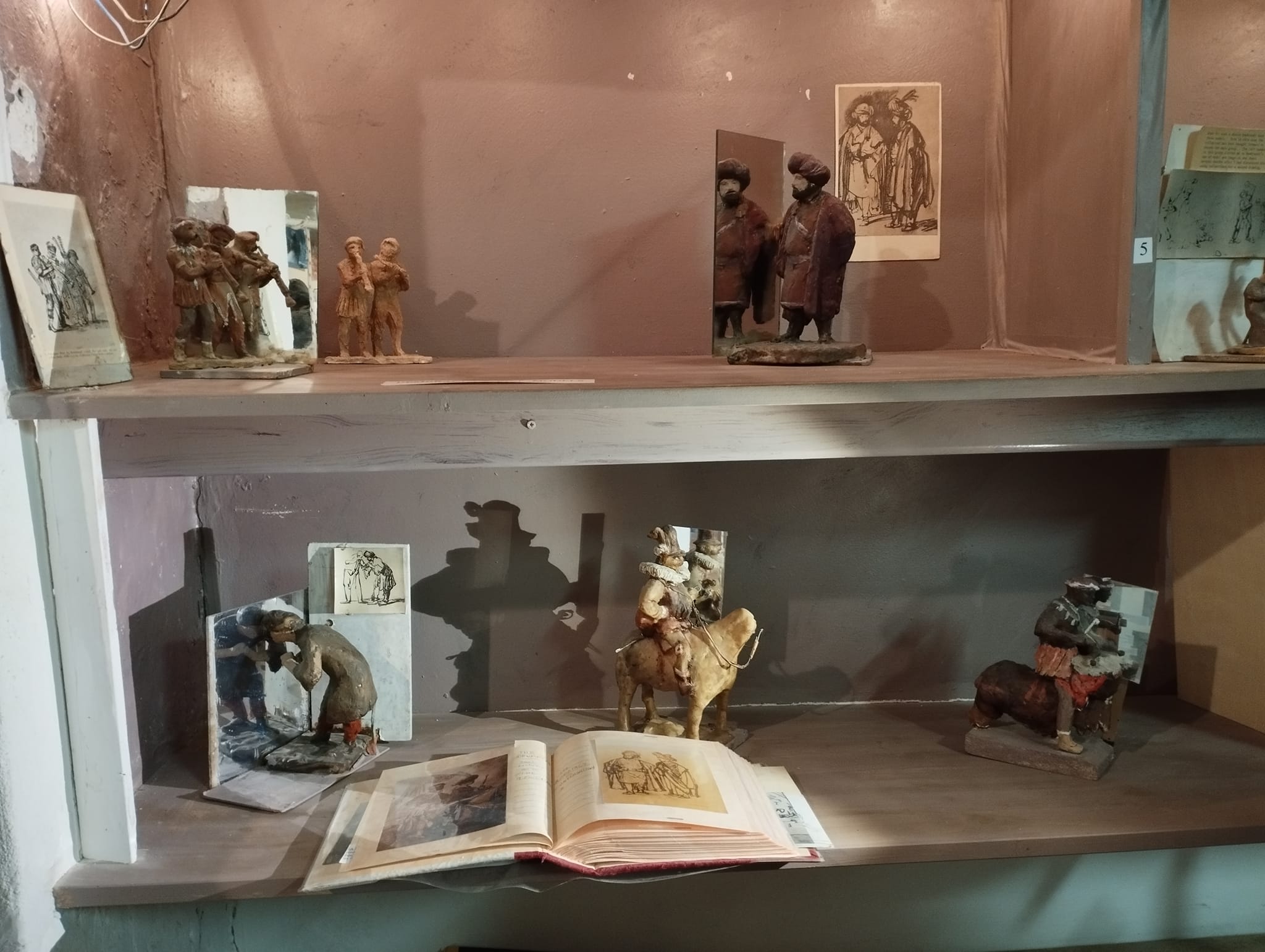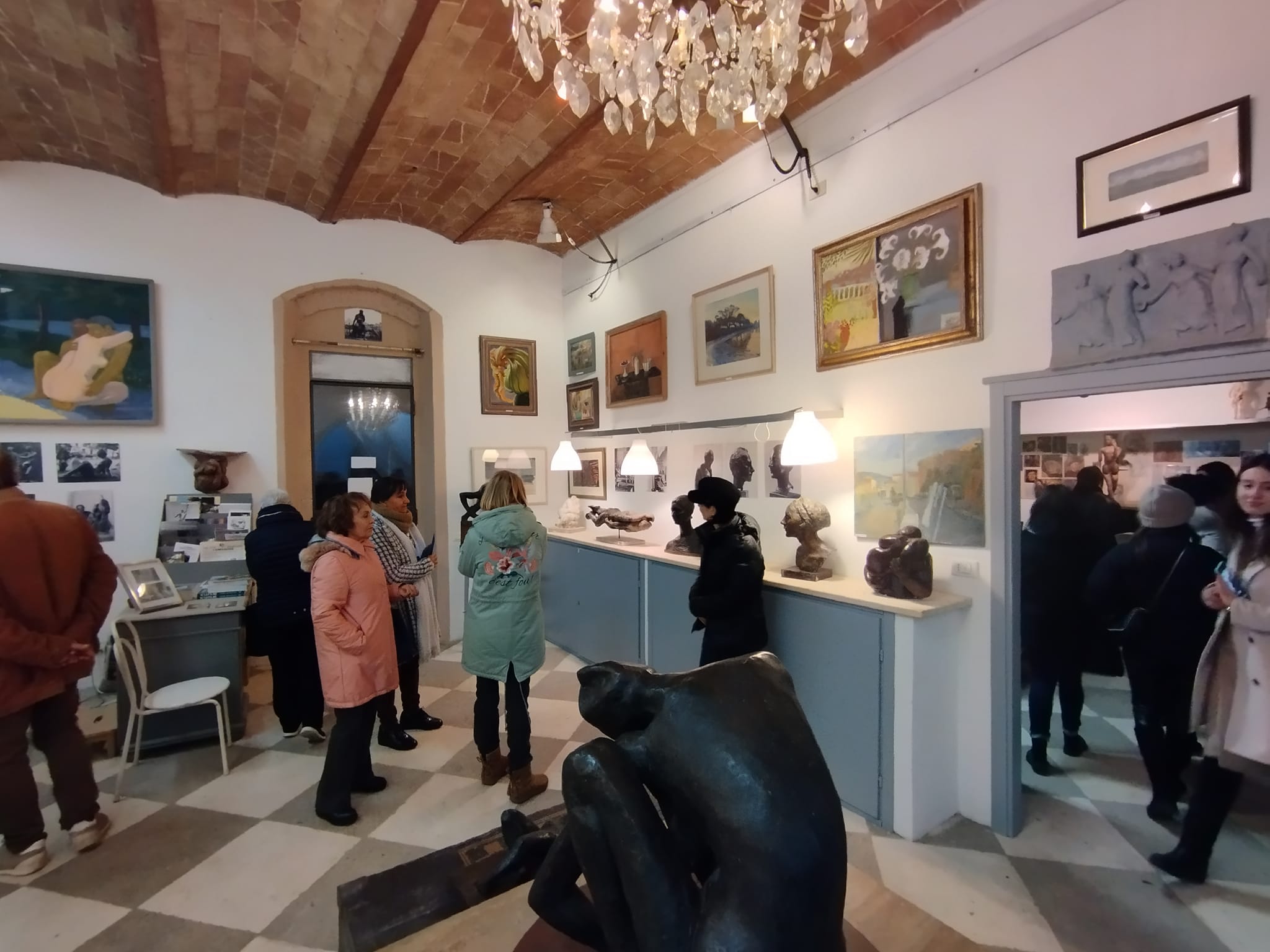OBITUARIES
Memories from Simon Gittins - a British neighbour of Nigel Konstam
Ricordi di Simon Gittins, un vicino di casa inglese di Nigel Konstam
L'articolo di Carolina Seaward per Il Tarlo
Caroline Seaward's article for "Il Tarlo" translated by Simon Gittins
AUTOBIOGRAPHY
Nigel's Autobiography which he completed during the Lockdown of 2020/2021. (This link takes you to NigelKonstam.com)
Memories from Simon Gittins - a British neighbour of Nigel Konstam
I first met Nigel Konstam on a cold winter’s day in late December 2016. I had come to Casole to visit my cousin Sheila Burns and see the Presepe Vivente. Almost as soon as we arrived Sheila took me to the enormous (and totally unheated!) sculpture-filled Centro d’Arte Verrocchio to meet her famous neighbour, the sculptor Nigel Konstam. I have a vivid memory of first encountering this extraordinary and charismatic small man. Although he was immediately warm and welcoming, he had very little interest in the “small talk” beloved of the English but almost immediately plunged into a description of ancient Greek sculpture and how the Bronzes of Riace MUST have been created using casts from living humans! This set much of the tone of my meetings with Nigel over the next years. When I left Casole a few days later, I departed with several books written by Nigel on his theories of art history, and most importantly a handwritten note giving me the name and telephone number of one Giorgio Stoppo, if I wanted to consider buying a property here…
A year later I was the owner of Via San Michele 4, a few metres from the Art Centre, and consequently now a close neighbour of Nigel’s. As a regular visitor to Casole, but not a resident, I learnt how Nigel was part of the fabric of the town - one would frequently see him surrounded by a crowd of adoring artistic English ladies, taking them through the streets of Casole and instructing them what to see and appreciate in this most attractive of towns. Although he was obviously a successful and active practicing sculptor, with his work in public places all around Casole, it was also clear that his second (or perhaps it was his first?) vocation was in communication and teaching. And also how his theories about the creation of artistic objects (especially Rembrandt’s painting but also classical sculptures and even Duccio), were passionately held with steel-like conviction. I also realised, despite being somewhat shy and quiet, how much he loved companionship and discussion. From this period I remember a long New Year’s Eve dinner at La Porrina at the end of 2019 when he warmed like a fire to congenial friends and conversation.
However, it was only from the summer of 2020, the first summer of the Pandemic, after I moved permanently to Casole, that I really got to know Nigel well. Life had changed profoundly for all of us, but particularly for Nigel - there were now no art classes, no English ladies and the long corridors and large rooms of the art school were now empty. To me it seemed that many of the reasons he had for being here had gone, and I expected him to be depressed, even devastated by the situation. Amazingly he took everything with extreme pragmatism and lack of sentimentality. He was convinced that the old Verrocchio Art Centre could never open again as in the past, but he still was bursting with ideas on how to restructure it when people could travel again. He also took the opportunity of this forced isolation to consolidate his legacy and spent many hours organising his writings, editing video lectures and writing an autobiography. He was realistic but not negative about his chances of survival with Covid “I have had a good life and long one. If it is my time then that is what will happen”. I was amazed at his energy, commitment, and determination to make the best of a very difficult situation.
Through the long lockdown winter of 2020-2021 we saw Nigel frequently and his company was always a beacon of light in those dark months. He was always entertaining and informed. It was touching how he was never the “great artist” but always was both very modest about his considerable accomplishments, and extraordinarily grateful when we made him the smallest of favours or assistance.
In addition to his own subjects of expertise, he was passionately interested in world news and was informed and curious about subjects as wide ranging as the climate crisis, the progress of Covid and its treatments, contemporary politics and many other issues. It was also fascinating to me, as a new foreigner living in Casole how he was able to tell me so much about the town and the people who lived here. A very endearing characteristic was his absolutely lack of malice or wish to gossip about those he knew personally. Two revealing exceptions were the Prime Minister of the United Kingdom and the then President of the United States, for both of which he had complete contempt! Throughout all this time he maintained an intellectual curiosity and physical agility far beyond his years.
It was so cruel that early this year, as the weather warmed and the pandemic waned and the first visitors in 3 years came to the Art Centre, that he was struck down by the physical infirmity he had avoided for so many years. It was perhaps a blessing he only had to endure a few months of a considerably restricted life before the end. But many people in Casole, in England, in America and many other countries will mourn a bright light extinguished from Casole, and I will miss him terribly.
Ricordi di Simon Gittins, un vicino di casa inglese di Nigel Konstam
Incontrai per la prima volta Nigel Konstam nel 2016, in una fredda giornata d’inverno di fine dicembre. Ero giunto a Casole per far visita a mia cugina, Sheila Burns, e vedere il “Presepe Vivente”. Appena arrivato o quasi, fui condotto da Sheila nell’enorme (e totalmente privo di riscaldamento!) Centro d’Arte Verrocchio, pieno di sculture, per fare la conoscenza del suo famoso vicino, lo scultore Nigel Konstam. Conservo un vivido ricordo del mio primo incontro con questo omino straordinario e carismatico. Per quanto ci avesse accolto immediatamente con grande calore, si mostrò assai poco interessato alle chiacchiere di circostanza, così predilette da noi inglesi, lanciandosi invece quasi subito in una descrizione della scultura nella Grecia antica e di come i bronzi di Riace dovevano SICURAMENTE essere stati creati utilizzando calchi presi da uomini in carne ed ossa! Queste furono pressappoco le premesse su cui si improntarono i miei incontri con Nigel negli anni a venire. Qualche giorno dopo, nel lasciare Casole, portai con me diversi libri scritti da Nigel sulle sue teorie di storia dell’arte e, cosa più importante ancora, una sua nota autografa contenente il nome e il numero di telefono di un certo Giorgio Stoppo, nel caso in cui avessi intenzione di comprare casa qui...
Un anno dopo ero diventato il proprietario dell’abitazione al numero 4 di Via San Michele, a pochi metri di distanza dal Centro d’Arte, e quindi a tutti gli effetti vicino di casa di Nigel. Durante le mie periodiche visite a Casole, ancora da non residente, mi resi conto di quanto Nigel fosse parte integrante di questo paese: lo si vedeva spesso per le vie di Casole, circondato da una folla adorante di signore inglesi appassionate d’arte, mentre le conduceva in giro indottrinandole su cosa vedere e ammirare in questa deliziosa cittadina. Sebbene fosse, senza ombra di dubbio, uno scultore affermato e ancora in attività, con opere esposte in numerosi luoghi pubblici in tutta Casole, era altrettanto evidente che la sua seconda (o forse prima?) vocazione fosse l’insegnamento e l’arte del comunicare. Anche le sue teorie sulla creazione di un’opera d’arte (specialmente i dipinti di Rembrandt, ma anche le sculture classiche e perfino Duccio) erano da lui sostenute con passione e ferrea convinzione. Capii anche quanto Nigel, nonostante fosse un uomo piuttosto mite e riservato, amasse la compagnia e la conversazione. Di questo periodo ricordo un lungo cenone di San Silvestro a ‘La Porrina’, alla fine del 2019, mentre si infervorava in discussioni animate con gli amici a lui congeniali.
Posso dire tuttavia che fu solo a partire dall’estate del 2020, la prima estate della pandemia, dopo il mio trasferimento definitivo a Casole, che cominciai a conoscere davvero Nigel. L’esistenza era cambiata profondamente per tutti noi, ma in particolar modo per Nigel: non più lezioni di arte, non più signore inglesi, i lunghi corridoi e gli ampi vani del Centro d’Arte ormai deserti. Mi sembrava che molti dei motivi che avevano indotto Nigel a vivere qui fossero svaniti, e mi immaginavo che la situazione sarebbe diventata deprimente, se non addirittura devastante per lui. Sorprendentemente, prese tutto con estrema pragmaticità, evitando qualsiasi sentimentalismo. Era convinto che il vecchio Centro d’Arte Verrocchio non sarebbe più tornato ad essere quello che era stato in passato, ma ciononostante era pieno di idee su come ristrutturarlo, una volta che le persone avessero ripreso a viaggiare. Questo isolamento forzato gli diede anche l’opportunità di riorganizzare i suoi lasciti e molte ore del suo tempo furono dedicate a mettere ordine fra i suoi scritti, rivedere i filmati delle sue lezioni e comporre un’autobiografia. Le sue probabilità di sopravvivenza nell’era del Covid erano realistiche, ma non dettate da pessimismo: “Ho vissuto una vita lunga e piena di soddisfazioni. Se arriverà il mio momento, allora sia quel che sia”. Sono rimasto stupito dalla sua energia, dal suo impegno, dalla sua volontà a trarre il meglio da una situazione così difficile.
Durante il lungo inverno del lockdown 2020-2021 furono molte le occasioni in cui vedemmo Nigel, e la sua compagnia fu sempre come un faro luminoso in quei mesi oscuri. Si teneva sempre informato ed era un piacere ascoltarlo. Era commovente vedere come non si comportasse mai come il “grande artista”, ma fosse sempre molto modesto riguardo ai suoi considerevoli successi, e al contempo straordinariamente grato nei nostri confronti, quando potevamo essergli d’aiuto o fargli anche il più piccolo dei favori.
Oltre ad essere un grande esperto nel suo campo, s’interessava con passione ai temi di attualità internazionale e si teneva aggiornato su argomenti che spaziavano dalla crisi climatica al Covid e alle sue terapie, dalla politica contemporanea a molte altre questioni. Per quel che mi riguarda, in quanto straniero da poco tempo residente a Casole, ero anche affascinato da quante cose conoscesse di questo paese e dei suoi antichi abitanti. Una dote che lo caratterizzava, e che me lo rendeva molto caro, era la sua totale mancanza di malizia e la sua incapacità di parlar male di coloro che conosceva. Due eccezioni a questa regola, a modo loro rivelatrici, erano il Primo Ministro del Regno Unito e l’ex-Presidente degli Stati Uniti, per i quali nutriva il più assoluto disprezzo! Per tutto questo periodo aveva mantenuto una curiosità intellettuale e un’agilità fisica di gran lunga superiori a quelle di una persona della sua età.
È stato davvero crudele che l’infermità, evitata per tanti anni, lo abbia colpito all’inizio di quest’anno, proprio mentre il clima si faceva più mite e la pandemia ci abbandonava, con l’arrivo al Centro d’Arte dei primi visitatori dopo ben 3 anni. È stato costretto a sopportare la mancanza di autonomia fisica solo per pochi mesi prima della fine, e forse in questo è stato fortunato. Ma molte persone a Casole, in Inghilterra, in America e in molti altri luoghi continueranno a piangere la scomparsa di una luce brillante dalla comunità di Casole, e io sentirò terribilmente la sua mancanza.
L'articolo di Carolina Seaward per "Il Tarlo"
Manca quella figura, leggermente piegata ultimamente, con i pantaloni spolverati di alabastro, una camicia sbiadita e i capelli spettinati, che andava a grandi passi verso la banca o i negozi per fare le sue commissioni. Salutava tutti alzando la mano o con qualche parola nel suo accento molto inglese.
Nigel Konstam è solo uno dei personaggi che ci sono venuti a mancare negli ultimi tempi. Non tutti lo conoscevono, non tutti erano interessati nella sua attività, era straniero - però ha lasciato un segno, una storia dietro di lui, e Casole non sarebbe diventato quello di oggi senza di lui.
Ha comprato il vecchio granaio della cooperativa rurale nel 1982, che all’epoca era una serie di stanzoni vuoti, il suo sogno era di aprire una scuola d‘arte tutta sua. Aveva deciso di lasciare le suoi origini in Inghilterra perchè, essendo artista e insegnante di arte, è rimasto deluso del modo di insegnare arte nelle scuole e università Inglesi. Si sentiva anche ingnorato dal mondo degli storici di arte perchè aveva delle idee piuttosto contro corrente.
Con l’aiuto di Alan Wrightson, disegnatore e muratore, cominciò a realizzare questo sogno. La moglie Janet stava al suo fianco ad affrontare le difficoltà della burocrazia Italiana e a sistemare le stanze. Ha chiamato questa struttura ‘Il Centro d’Arte Verrocchio’ - essendo un gioco sulla frase ‘vero occhio’ e il nome di uno degli artisti Fiorentini più importanti del Rinascimento, Andrea del Verrocchio. Nigel era orgoglioso del fatto di stare nella culla dell’arte Rinascimentale Italiana.
I primi gruppi di studenti che venivano all’inizio dell’attivtà erano delle studenti femminili da una scuola Inglese, e poi in seguito delle studenti da un università Australiana. Dopo le lezioni di arte queste ragazze belle, giovani e lontane da casa loro andavano a socializzare nei locali del paese, e una intera generazione di giovani Casolesi si ricorderà di quei tempi … Janet ha dovuto spesso insieme a Nigel uscire nel bel mezzo della notte in cerca delle studentesse che non erano ancora rientrate.
Entro la fine degli anni ‘80 I corsi estivi di pittura e scultura con vitto e alloggio erano ben stabiliti, portando al paese un importante flusso di stranieri di tutte l’età e abilità e da diversi paesi e culture. Tutti usavano i servizi in paese – bar, ristoranti, negozi - aiutando così anche le altre attività. E Nigel si fidava anche degli altri artigiani del paese - i muratori, l’elettricista, l’idraulico.
Oltre questo, Nigel ha portato il nome di Casole in tutto il mondo – se c’è qualcuno in California o Islanda che conosce il nome di Casole è perchè è stato al Centro d’Arte a fare un corso di pittura e scultura.
All’inizio mi sentivo in soggezione davanti a Nigel, ma l’ho visto sempre cortese, disponibile, gentile e paziente con tutti, anche con gli studenti più negati. Durante tutte le estati stava a cena ogni sera con gli ospiti del Centro d’Arte ad essere simpatico con qualcuno che voleva raccontare I suoi problemi, oppure era lui a raccontare storie divertenti della sua vita in Italia, o spiegare le sue teorie sul pittore Olandese Rembrandt, o la differenza fra l’arte dei Greci e Romani.
E successo in più di un’occasione che la sera della cena del Palio veniva un temporale all’improviso, e la cena della Pievalle in piazzetta davanti alla sua porta principale rischiava di essere un disastro. Così Nigel ha aperto la sua porta, e ha fatto entrare tutti in casa sua.
Nigel era un eccentrico, un visionario: il suo modo di fare le chiusure delle porte con un peso fatto di una bottiglia di plastica piena di acqua e un filo di spago, oppure il suo ‘pannelo solare’ per scaldare l’acqua della piscina interna che era un tubo di gomma in un cerchio in terrazza sotto il sole – questi erano cose geniali che facevano divertire la gente, però funzionavano.
Lo chiamavano ‘il Maestro’ o ‘il professore’, che gli dava piacere. Le sue opere sono situate in diversi angoli del paese – il Crocifisso, il Buon Samaritano, il Figlio Prodigo sono solo alcuni. Nigel era sempre attivo, o a creare le sue opere, a prendere cura del giardino in terrazza, o a leggere o scrivere le sue osservazioni o teorie – aveva sempre dei taccuini lasciati in giro. Nell’inverno quando gli ospiti non c’erano più, lavorava nel laboratorio vestito in 2 paia di pantaloni, diversi strati di maglie vecchie, qualche strano cappello. Quando c’era il sole, si faceva la penichella dalle h14-15 in terrazza nella parte più soleggiata e al riparo dal vento. Continuerò a vederlo sempre lì, fra le mura del suo sogno circondato dai suoi spazi, dalle sue opere e dei suoi pensieri.
Caroline Seaward's article for "Il Tarlo" translated by Simon Gittins
“The VISIONARY"
IN MEMORY OF NIGEL KONSTAM (Caroline Seaward)
We will all miss his presence, in recent years somewhat bent over, with his trousers dusty from alabaster, a faded shirt and unkempt hair, striding towards the bank or the shops of Casole on his errands. As he walked, he would greet everyone with a raised hand or with a few words in his strong English accent.
Nigel Konstam is just one of several Casole personalities who we have lost recently. Not everyone knew him, not everyone was interested in what he did, and he also was a foreigner, but he undoubtably left his mark on Casole, and the town would not have become what it is today without him.
He bought the old grain store of the Casole rural cooperative in 1982, which at that time was just a series of abandoned rooms, his dream being to use them for an art school of his own. He had decided to leave behind his roots in England, because, being an artist and art teacher, he had become disillusioned with the way art was taught in British schools and universities. Furthermore, he felt ignored by the world of art historians because of his somewhat unorthodox theories and ideas on aspects of art history.
With the help of Alan Wrightson, a designer and builder, he began to realize this dream.
His wife Janet supported him both in navigating the difficulties of Italian bureaucracy and in creating an art centre from the disused rooms of the old grain store.
He called this structure "The Verrocchio Art Centre" the name “Verrocchio” being both a play on the Italian phrase “vero occhio”, meaning “true vision” and also being the name of one of the most important artists of the Florentine Renaissance, Andrea del Verrocchio
- Nigel was proud of the Centre’s location in Tuscany, the cradle of Italian Renaissance art.
The first groups of students who came at the beginning of the Centre’s activites were students from from an English art school, and these were followed by students from an Australian university. After their art lessons these attractive young women, far from home, would go out to socialize in the bars and restaurants of Casole. A whole generation of young Casolesi certainly well remember those times .... Janet often had to go out with Nigel in the middle of the night in search of the students who had not yet returned to the Centre.
By the late 1980s, summer painting and sculpture courses with room and board at the Centre were well established, bringing to the town a significant stream of foreigners of all ages and abilities, from different countries and cultures. They all used the services of Casole – its bars, restaurants, and shops – and by so doing, helping other businesses as well. And in addition, Nigel also used workers in the town such as builders, electricians and plumbers. Nigel’s Art Centre also has carried the name of Casole d’Elsa all over the world -
if there is anyone in California or Iceland who knows of Casole, it will probably be because they were at the Art Centre to take a painting or sculpture course.
At first I felt in awe of Nigel, but I always found him courteous, helpful, kind and patient with everyone, even with the more challenged students. Throughout summer evenings he could be found at dinner with the guests of the Centre, animatedly and freely conversing with everyone, taking particular attention of anyone who wanted to discuss their problems, but also telling amusing anecdotes of his life in Italy, or explaining his theories on Rembrandt, or the difference between the art of the Greeks and Romans.
On more than one occasion a sudden summer storm occurred on the night of the important annual dinner held on the eve of the Casole Palio, risking disaster for the Pievalle Contrada dinner, which is held in the piazza in front of the Art Centre. At these times Nigel would open his front door and let everyone in, so the party could proceed under his roof.
Nigel was an eccentric but was also a visionary: for example his way of closing doors with a weight made from a plastic bottle full of water and a thread of string, or his "solar panel" for heating the water of the indoor pool with a rubber tube wrapped in a coil on the terrace exposed to the sun - these were brilliant ideas that entertained people, and yet they worked.
They called him “the Maestro" or “the Professor" and this pleased him.
His works are located all over Casole – his sculptures of the Crucifixion, the Good Samaritan and the Prodigal Son are just some examples. Nigel was always intent on working – either in the process of artistic creation - the "Tac tac tac" of hammer on chisel was almost a sound of summer, emanating from his Studio - or by cultivating his garden on the Centre’s terrace - or by writing his observations and theories (he always had notebooks lying around).
The Konstam Museum in via San Michele will remain open on appointment. Many of his works in alabaster and bronze are exhibited here, and there are also explanations of
his theories on Rembrandt, the art of the Greeks and Romans and much more.
In the winter when the guests were gone, he used to work in his winter work clothes - with two pairs of trousers, several layers of old shirts and some odd looking hats. When the sun was out he would usually take a nap between 2 and 3 pm on the part of the terrace which is sunnier and sheltered from the wind. In my mind’s eye I will always see him there, within the walls of his dream, surrounded by the space he created, his own works and his thoughts.
























